-
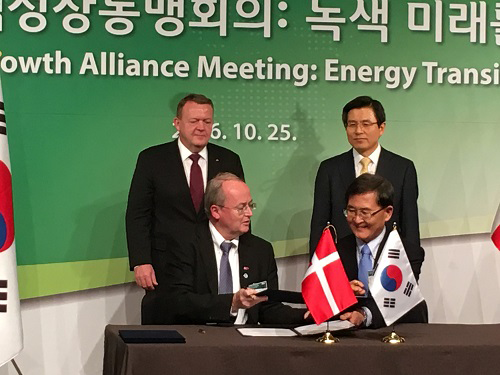 MOU between KAIST and DTU Signed
KAIST and the Technical University of Denmark (DTU) signed a memorandum of understanding (MOU) to cooperate in the areas of startup, student exchange, and joint research on October 25, 2016 at the Embassy of Denmark in Seoul, Korea. Under the agreement, KAIST and DTU will exchange students and researchers through startup programs and continue to collaborating in education and research.
The MOU was facilitated during the Green Growth Alliance Meeting and Energy Seminar hosted by the Danish embassy, in which Danish Prime Minister Lars Løkke Rasmussen participated.
President Steve Kang of KAIST, who fostered the agreement, said,
“DTU has been one of our strategic partners in Europe. We have been working closely with them on academic exchanges and research collaborations, but now with the expansion of our cooperation into entrepreneurship, we will create momentum to spur startups in both schools. To support such activities, we will use KAIST’s experiences acquired from operating the K-School, an entrepreneurship graduate school, and the Institute of KAIST Entrepreneurship. DTU will also share their knowledge on startup programs including SkyLab and StartDTU. I believe this will become another successful alliance between the two universities.”
As of October 2016, KAIST has made 18 agreements with DTU, exchanging 120 students in the past three years and implementing various joint seminars and conferences for academic and research exchanges.
Established in 1829, DTU has been a leading science and technology university in Denmark. It ranked 109 in the QS World University Rankings 2016 and 46th in its subject rankings in engineering and technology.
In the picture below, President Steve Kang of KAIST (right) and Senior Vice President Martin P. Bendsøe of the Technical University of Denmark (left) are signing an agreement for academic and research cooperation.
2016.10.27 View 8565
MOU between KAIST and DTU Signed
KAIST and the Technical University of Denmark (DTU) signed a memorandum of understanding (MOU) to cooperate in the areas of startup, student exchange, and joint research on October 25, 2016 at the Embassy of Denmark in Seoul, Korea. Under the agreement, KAIST and DTU will exchange students and researchers through startup programs and continue to collaborating in education and research.
The MOU was facilitated during the Green Growth Alliance Meeting and Energy Seminar hosted by the Danish embassy, in which Danish Prime Minister Lars Løkke Rasmussen participated.
President Steve Kang of KAIST, who fostered the agreement, said,
“DTU has been one of our strategic partners in Europe. We have been working closely with them on academic exchanges and research collaborations, but now with the expansion of our cooperation into entrepreneurship, we will create momentum to spur startups in both schools. To support such activities, we will use KAIST’s experiences acquired from operating the K-School, an entrepreneurship graduate school, and the Institute of KAIST Entrepreneurship. DTU will also share their knowledge on startup programs including SkyLab and StartDTU. I believe this will become another successful alliance between the two universities.”
As of October 2016, KAIST has made 18 agreements with DTU, exchanging 120 students in the past three years and implementing various joint seminars and conferences for academic and research exchanges.
Established in 1829, DTU has been a leading science and technology university in Denmark. It ranked 109 in the QS World University Rankings 2016 and 46th in its subject rankings in engineering and technology.
In the picture below, President Steve Kang of KAIST (right) and Senior Vice President Martin P. Bendsøe of the Technical University of Denmark (left) are signing an agreement for academic and research cooperation.
2016.10.27 View 8565 -
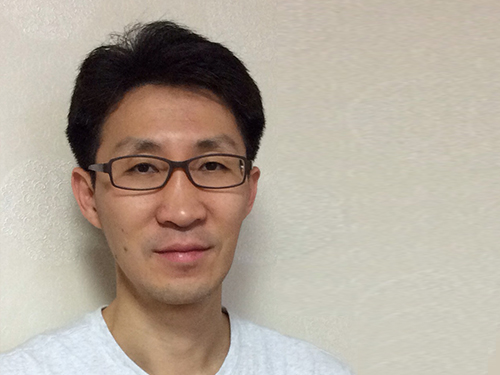 Professor Shin's Team Receives the Best Software Defined Network Solution Showcase Award
Professor Seungwon Shin of the Electrical Engineering School at KAIST and his research team won the Best Software Defined Networking (SDN) Solution Showcase Award hosted by the SDN World Congress, one of the biggest network summits held in Europe with over 2,000 participants. This year the conference took place in The Hague, the Netherlands, October 10-14, 2016.
SDN is an approach to computer networking that allows network administrators to respond quickly to changing business requirements via a centralized control console and to support the dynamic, scalable computing and storage needs of more modern computing environments such as data centers.
Collaborating with researchers from Queen’s University in the United Kingdom and Huawei, a global information and communications technology solutions provider in China, Professor Shin’s team, which is led by doctoral students Seungsoo Lee, Changhoon Yoon, and Jaehyun Nam, implemented a SDN security project called “DELTA.” ATTORESEARCH, a Korean SDN architecture and applications provider, conducted testing and verification for the project.
DELTA is a new SDN security evaluation framework with two main functions. It can automatically recognize attack cases against SDN elements across diverse environments and can assist in identifying unknown security problems within a SDN deployment.
The DELTA project consists of a control plane, the part of a network that carries signaling traffic and is responsible for routing; a data plane, the part of a network that carries user traffic; and a control channel that connects the two aforementioned planes. These three components have their own agents installed, which are all controlled by an agent manger. The agent manger can automatically detect any spots where the network security is weak.
Specifically, the project aimes to defense attacks against OpenFlow protocol, one of the first SDN standards; SDN controllers, a network operating system that is based on protocols; and network switch devices that use OpenFlow protocol.
The DELTA project was registered with the Open Networking Foundation, a user-driven organization dedicated to the promotion and adoption of SDN through open standards development, as an open source SDN security evaluation tool. This project is the only open source SDN which has been led by Korean researchers.
The SDN World Congress 2016 recognized the need for and importance of the DELTA project by conferring upon it the Best Solution Showcase Award. The Open Networking Foundation also widely publicized this award news.
Professor Shin said:
“In recent years, SDN has been attracting a large amount of interest as an emerging technology, but there still have not many SDN projects in Korea. This award acknowledges the advancement of Korean SDN technology, showing the potential for Korea to become a leader in SDN research.”
Picture: Major Components of the DELTA Project: Agents and Agent Manger
2016.10.25 View 9767
Professor Shin's Team Receives the Best Software Defined Network Solution Showcase Award
Professor Seungwon Shin of the Electrical Engineering School at KAIST and his research team won the Best Software Defined Networking (SDN) Solution Showcase Award hosted by the SDN World Congress, one of the biggest network summits held in Europe with over 2,000 participants. This year the conference took place in The Hague, the Netherlands, October 10-14, 2016.
SDN is an approach to computer networking that allows network administrators to respond quickly to changing business requirements via a centralized control console and to support the dynamic, scalable computing and storage needs of more modern computing environments such as data centers.
Collaborating with researchers from Queen’s University in the United Kingdom and Huawei, a global information and communications technology solutions provider in China, Professor Shin’s team, which is led by doctoral students Seungsoo Lee, Changhoon Yoon, and Jaehyun Nam, implemented a SDN security project called “DELTA.” ATTORESEARCH, a Korean SDN architecture and applications provider, conducted testing and verification for the project.
DELTA is a new SDN security evaluation framework with two main functions. It can automatically recognize attack cases against SDN elements across diverse environments and can assist in identifying unknown security problems within a SDN deployment.
The DELTA project consists of a control plane, the part of a network that carries signaling traffic and is responsible for routing; a data plane, the part of a network that carries user traffic; and a control channel that connects the two aforementioned planes. These three components have their own agents installed, which are all controlled by an agent manger. The agent manger can automatically detect any spots where the network security is weak.
Specifically, the project aimes to defense attacks against OpenFlow protocol, one of the first SDN standards; SDN controllers, a network operating system that is based on protocols; and network switch devices that use OpenFlow protocol.
The DELTA project was registered with the Open Networking Foundation, a user-driven organization dedicated to the promotion and adoption of SDN through open standards development, as an open source SDN security evaluation tool. This project is the only open source SDN which has been led by Korean researchers.
The SDN World Congress 2016 recognized the need for and importance of the DELTA project by conferring upon it the Best Solution Showcase Award. The Open Networking Foundation also widely publicized this award news.
Professor Shin said:
“In recent years, SDN has been attracting a large amount of interest as an emerging technology, but there still have not many SDN projects in Korea. This award acknowledges the advancement of Korean SDN technology, showing the potential for Korea to become a leader in SDN research.”
Picture: Major Components of the DELTA Project: Agents and Agent Manger
2016.10.25 View 9767 -
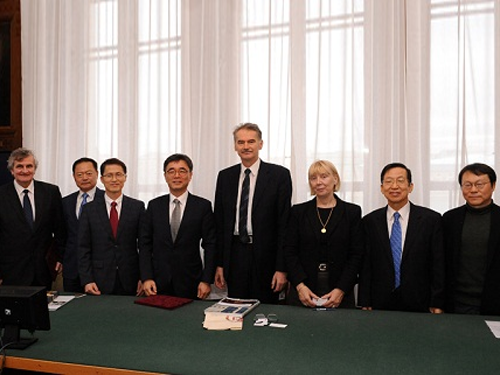 KAIST and the Budapest University of Technology and Economics Agree to Cooperate in Education and Research
KAIST and the Budapest University of Technology and Economics in Hungary extended their existing agreement for comprehensive cooperation in education and research, and signed a new memorandum of understanding (MOU) for student exchanges on October 19, 2016, at Budapest University.
The two universities will exchange faculty, researchers, and students for education and research collaboration, implement dual degree programs, conduct joint lectures and research projects, and share infrastructures and talent pools.
These agreements were part of the agenda for the 8th Meeting of the Korea and Hungary Science and Technology Joint Committee, which took place October 17-19, 2016, in Budapest.
President Sung-Mo Kang of KAIST, Associate Vice President Sung-Hyon Myaeng of the International Office, and Director General Won-Ho Choi of International Relations at the Ministry of Science, ICT and Future Planning of Korea were present at the MOU singing.
Associate Vice President Myaeng said:
“Traditionally, the Budapest University of Technology and Economics has been known for its strong base in the natural sciences. Combining this with KAIST’s excellence in engineering, the two universities will bring synergistic effects that will help further develop the schools as well as their host nations.”
“Finding partners to implement joint research projects sponsored by the European Union or establishing cooperative networks among future talents between the two countries through various student exchange programs can be a good starting point,” he added.
The Budapest University of Technology and Economics was created in 1782, and is one of the most prestigious universities in Hungary, having produced three Nobel Prize laureates. It has a highly-globalized campus, where one third of its student population is made up of international students, and offers lectures and research in English.
In addition, the Hungarian-Korean Technical Cooperation Center Foundation, established in 1992 and based in Budapest, hosted a seminar on science in Korea and Hungary on October 17, 2016. At the seminar, Korean and Hungarian participants discussed issues on the two nations’ science, technology, and strategies to drive innovation under the topic “The Technical Innovation-Importance of Startup Companies.”
Associate Vice President Sung-Hyon Myaeng of the International Office, KAIST, is pictured fourth from the left, and János Józsa, rector of the Budapest University of Technology and Economics, is fifth from the left.
2016.10.20 View 8725
KAIST and the Budapest University of Technology and Economics Agree to Cooperate in Education and Research
KAIST and the Budapest University of Technology and Economics in Hungary extended their existing agreement for comprehensive cooperation in education and research, and signed a new memorandum of understanding (MOU) for student exchanges on October 19, 2016, at Budapest University.
The two universities will exchange faculty, researchers, and students for education and research collaboration, implement dual degree programs, conduct joint lectures and research projects, and share infrastructures and talent pools.
These agreements were part of the agenda for the 8th Meeting of the Korea and Hungary Science and Technology Joint Committee, which took place October 17-19, 2016, in Budapest.
President Sung-Mo Kang of KAIST, Associate Vice President Sung-Hyon Myaeng of the International Office, and Director General Won-Ho Choi of International Relations at the Ministry of Science, ICT and Future Planning of Korea were present at the MOU singing.
Associate Vice President Myaeng said:
“Traditionally, the Budapest University of Technology and Economics has been known for its strong base in the natural sciences. Combining this with KAIST’s excellence in engineering, the two universities will bring synergistic effects that will help further develop the schools as well as their host nations.”
“Finding partners to implement joint research projects sponsored by the European Union or establishing cooperative networks among future talents between the two countries through various student exchange programs can be a good starting point,” he added.
The Budapest University of Technology and Economics was created in 1782, and is one of the most prestigious universities in Hungary, having produced three Nobel Prize laureates. It has a highly-globalized campus, where one third of its student population is made up of international students, and offers lectures and research in English.
In addition, the Hungarian-Korean Technical Cooperation Center Foundation, established in 1992 and based in Budapest, hosted a seminar on science in Korea and Hungary on October 17, 2016. At the seminar, Korean and Hungarian participants discussed issues on the two nations’ science, technology, and strategies to drive innovation under the topic “The Technical Innovation-Importance of Startup Companies.”
Associate Vice President Sung-Hyon Myaeng of the International Office, KAIST, is pictured fourth from the left, and János Józsa, rector of the Budapest University of Technology and Economics, is fifth from the left.
2016.10.20 View 8725 -
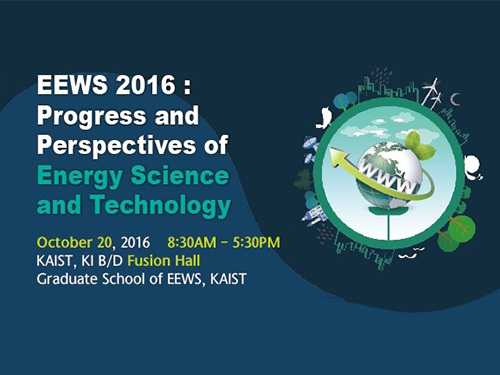 2016 KAIST EEWS Workshop
The Energy, Environment, Water and Sustainability (EEWS) Graduate School of KAIST hosted a workshop entitled “Progress and Perspectives of Energy Science and Technology” on October 20, 2016. The workshop took place at the Fusion Hall of the KAIST Institute on campus.
About 400 experts in energy science and engineering participated in the event. Eight globally recognized scientists introduced the latest research trends in nanomaterials, energy theory, catalysts, and photocatalysts and led discussions on the current status and prospects of EEWS.
Professors Yi Cui of Stanford University, an expert in nanomaterials, and William A. Goddard of California Institute of Technology presented their research experiments on materials design and recent results on the direction of theory under the topics of energy and environment.
Dr. Miquel Salmeron, a former head of the Material Science Division of Lawrence Berkeley National Laboratory, and Professor Yuichi Ikuhara of Tokyo University introduced their analysis of catalysts and energy matters at an atomic scale.
Professor Sukbok Chang of the Chemistry Department at KAIST, a deputy editor of ACS Catalysis and the head of the Center for Catalytic Hydrocarbon Functionalizations at the Institute of Basic Science, and Professor Yang-Kook Sun of Energy Engineering at Hanyang University, who is also a deputy editor of ACS Energy Letters, presented their latest research results on new catalytic reaction development and energy storage.
The workshop consisted of three sections which addressed the design of energy and environment materials; analysis of energy and catalytic materials; and energy conversion and catalysts.
The EEWS Graduate School was established in 2008 with the sponsorship of the Korean government’s World Class University (WCU) project to support science education in Korea. Professor J. Fraser Stoddart, the winner of the 2016 Nobel Prize in Chemistry, was previously worked at the KAIST EEWS Graduate School as a WCU visiting professor for two years, from 2011 to 2013. Professor Ali Coskun, who was a postdoctoral researcher in the laboratory of Professor Stoddart, now teaches and conducts research as a full-time professor at the graduate school.
Dean Yousung Jung of the EEWS Graduate School said:
“This workshop has provided us with a meaningful opportunity to engage in discussions on energy science and technology with world-class scholars from all around the world. It is also a good venue for our graduate school to share with them what we have been doing in research and education.”
2016.10.20 View 14329
2016 KAIST EEWS Workshop
The Energy, Environment, Water and Sustainability (EEWS) Graduate School of KAIST hosted a workshop entitled “Progress and Perspectives of Energy Science and Technology” on October 20, 2016. The workshop took place at the Fusion Hall of the KAIST Institute on campus.
About 400 experts in energy science and engineering participated in the event. Eight globally recognized scientists introduced the latest research trends in nanomaterials, energy theory, catalysts, and photocatalysts and led discussions on the current status and prospects of EEWS.
Professors Yi Cui of Stanford University, an expert in nanomaterials, and William A. Goddard of California Institute of Technology presented their research experiments on materials design and recent results on the direction of theory under the topics of energy and environment.
Dr. Miquel Salmeron, a former head of the Material Science Division of Lawrence Berkeley National Laboratory, and Professor Yuichi Ikuhara of Tokyo University introduced their analysis of catalysts and energy matters at an atomic scale.
Professor Sukbok Chang of the Chemistry Department at KAIST, a deputy editor of ACS Catalysis and the head of the Center for Catalytic Hydrocarbon Functionalizations at the Institute of Basic Science, and Professor Yang-Kook Sun of Energy Engineering at Hanyang University, who is also a deputy editor of ACS Energy Letters, presented their latest research results on new catalytic reaction development and energy storage.
The workshop consisted of three sections which addressed the design of energy and environment materials; analysis of energy and catalytic materials; and energy conversion and catalysts.
The EEWS Graduate School was established in 2008 with the sponsorship of the Korean government’s World Class University (WCU) project to support science education in Korea. Professor J. Fraser Stoddart, the winner of the 2016 Nobel Prize in Chemistry, was previously worked at the KAIST EEWS Graduate School as a WCU visiting professor for two years, from 2011 to 2013. Professor Ali Coskun, who was a postdoctoral researcher in the laboratory of Professor Stoddart, now teaches and conducts research as a full-time professor at the graduate school.
Dean Yousung Jung of the EEWS Graduate School said:
“This workshop has provided us with a meaningful opportunity to engage in discussions on energy science and technology with world-class scholars from all around the world. It is also a good venue for our graduate school to share with them what we have been doing in research and education.”
2016.10.20 View 14329 -
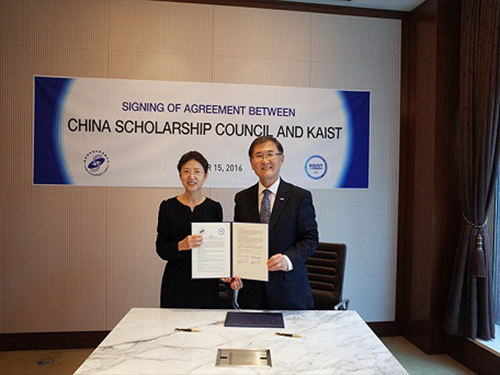 KAIST Signs an Agreement with CSC for Cooperation
KAIST and the China Scholarship Council (CSC) established a memorandum of understanding (MOU) to support the admission of Chinese students to KAIST on October 5, 2016 in Seoul. KAIST is the only institution in Korea made such agreement with the CSC.
Affiliated with the Ministry of Education of China, the CSC is a non-profit institution that provides financial assistance to Chinese students to study abroad and to internationals wishing to study in China. The CSC has supported 500,000 Chinese students for their studying and living in a foreign country, and this year alone, it provided outbound Chinese students with scholarships of approximately USD 100 million.
Under the MOU, Chinese students admitted to KAIST’s master’s and doctoral programs will receive finical support from CSC, including monthly stipends and roundtrip airfare from China to Korea.
President Sung-Mo Kang of KAIST said, “This is a great opportunity for us because we can invite more outstanding Chinese students. They will make our campus more diverse and global, while their academic experiences will become richer with KAIST’s offerings in education and research. I hope many Chinese students will capitalize on this chance to come to KAIST for their advanced degrees in science and technology.”
In the picture below, President Steve Kang of KAIST, on the right, is pictured with Secretary General Liu Jinghui of China Scholarship Council.
2016.10.19 View 7101
KAIST Signs an Agreement with CSC for Cooperation
KAIST and the China Scholarship Council (CSC) established a memorandum of understanding (MOU) to support the admission of Chinese students to KAIST on October 5, 2016 in Seoul. KAIST is the only institution in Korea made such agreement with the CSC.
Affiliated with the Ministry of Education of China, the CSC is a non-profit institution that provides financial assistance to Chinese students to study abroad and to internationals wishing to study in China. The CSC has supported 500,000 Chinese students for their studying and living in a foreign country, and this year alone, it provided outbound Chinese students with scholarships of approximately USD 100 million.
Under the MOU, Chinese students admitted to KAIST’s master’s and doctoral programs will receive finical support from CSC, including monthly stipends and roundtrip airfare from China to Korea.
President Sung-Mo Kang of KAIST said, “This is a great opportunity for us because we can invite more outstanding Chinese students. They will make our campus more diverse and global, while their academic experiences will become richer with KAIST’s offerings in education and research. I hope many Chinese students will capitalize on this chance to come to KAIST for their advanced degrees in science and technology.”
In the picture below, President Steve Kang of KAIST, on the right, is pictured with Secretary General Liu Jinghui of China Scholarship Council.
2016.10.19 View 7101 -
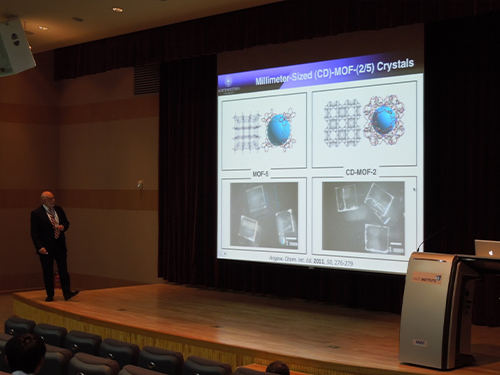 J. Fraser Stoddart, a Former Visiting Professor at KAIST, Wins the 2016 Nobel Prize in Chemistry
J. Fraser Stoddart, who is Northwestern University’s Board of Trustees Professor of Chemistry and head of the Stoddart Mechanostereochemistry Group, received the 2016 Nobel Prize in Chemistry. He shares it with Professor Jean-Pierre Sauvage of the University of Strasbourg in France and Professor Bernard Feringa of the University of Groningen in the Netherlands.
Professor Stoddart’s relationship with KAIST dates to his term as a visiting professor from 2011 to 2013 at the Environment, Energy, Water and Sustainability (EEWS) Graduate School. The Nobel Committee awarded the prize to Professor Stoddart in recognition of his pioneering work on artificial molecular machines, a.k.a., nanomachines.
A molecular machine is an assembly of a discrete number of molecular components designed to perform machine-like movements as the result of appropriate external stimuli. Like their counterparts in the macroscopic world, molecular machines control mechanical movements and rotations in response to an energy input such as chemical reactions, light, or temperature. The most complex molecular machines, for example, are proteins in cells. Chemists have attempted to imitate these structures for potential applications including smart nanomedicines to track diseases such as cancer cells and deliver drugs to fight them. Other applications include next-generation miniature semiconductor chips, sensors, energy storage, space exploration, and armaments.
In 1991, Professor Stoddart developed artificial molecular machines based on a rotaxane. A rotaxane is a mechanically-interlocked molecular architecture in which a dumbbell-shaped molecule is encircled by a molecular ring called a macrocycle. He presented important research on the production of rotaxanes and demonstrated that a macrocycle could move along or rotate freely around the axle, a dumbbell-shaped molecule.
Professor Stoddart is also an expert in molecular electronics using molecules on the nanoscale as switches in computers and other electronic devices. In 2007, he created a large-scale ultra-dense memory device with reconfigurable molecular switches, the size of white blood cells but capable of storing information. This was a significant achievement towards the development of molecular computers that are much smaller and more powerful compared to today’s silicon-based computers.
KAIST has enjoyed a strong relationship with Professor Stoddart since he served as a visiting professor at the EEWS Graduate School from 2011 to 2013. The graduate school invited him to participate in the Korean government’s science and education program to foster world-class universities in the nation. At KAIST, he taught a course entitled “Nanomachines at the Scale of Molecules.” He also collaborated with Korean researchers on various projects including the publication of a joint research paper, “A Radically Configurable Six-State Compound,” in Science (January 25, 2013) with Professor Jang Wook Choi from the EEWS Graduate School and researchers from the United States, the United Kingdom, and Saudi Arabia.
Two doctors with KAIST ties have links to Professor Stoddart as well. In 2012, Dr. Ali Coskun, who worked with him as a postdoctoral research associate at Northwestern University, became an associate professor at the EEWS Graduate School where he conducts research on secondary batteries and gas storage with artificial molecular machines. Dr. Dong Jun Kim, a KAIST graduate, has been working at the Stoddart Mechanostereochemistry Group as a postdoctoral fellow since 2015.
Picture 1: Synthesis of a Rotaxane Described in the Journal of the American Chemical Society (JACS) in 1991
Picture 2: Professor J. Fraser Stoddart Giving a Presentation at a Workshop Hosted by the EEWS Graduate School at KAIST in 2011
2016.10.13 View 9177
J. Fraser Stoddart, a Former Visiting Professor at KAIST, Wins the 2016 Nobel Prize in Chemistry
J. Fraser Stoddart, who is Northwestern University’s Board of Trustees Professor of Chemistry and head of the Stoddart Mechanostereochemistry Group, received the 2016 Nobel Prize in Chemistry. He shares it with Professor Jean-Pierre Sauvage of the University of Strasbourg in France and Professor Bernard Feringa of the University of Groningen in the Netherlands.
Professor Stoddart’s relationship with KAIST dates to his term as a visiting professor from 2011 to 2013 at the Environment, Energy, Water and Sustainability (EEWS) Graduate School. The Nobel Committee awarded the prize to Professor Stoddart in recognition of his pioneering work on artificial molecular machines, a.k.a., nanomachines.
A molecular machine is an assembly of a discrete number of molecular components designed to perform machine-like movements as the result of appropriate external stimuli. Like their counterparts in the macroscopic world, molecular machines control mechanical movements and rotations in response to an energy input such as chemical reactions, light, or temperature. The most complex molecular machines, for example, are proteins in cells. Chemists have attempted to imitate these structures for potential applications including smart nanomedicines to track diseases such as cancer cells and deliver drugs to fight them. Other applications include next-generation miniature semiconductor chips, sensors, energy storage, space exploration, and armaments.
In 1991, Professor Stoddart developed artificial molecular machines based on a rotaxane. A rotaxane is a mechanically-interlocked molecular architecture in which a dumbbell-shaped molecule is encircled by a molecular ring called a macrocycle. He presented important research on the production of rotaxanes and demonstrated that a macrocycle could move along or rotate freely around the axle, a dumbbell-shaped molecule.
Professor Stoddart is also an expert in molecular electronics using molecules on the nanoscale as switches in computers and other electronic devices. In 2007, he created a large-scale ultra-dense memory device with reconfigurable molecular switches, the size of white blood cells but capable of storing information. This was a significant achievement towards the development of molecular computers that are much smaller and more powerful compared to today’s silicon-based computers.
KAIST has enjoyed a strong relationship with Professor Stoddart since he served as a visiting professor at the EEWS Graduate School from 2011 to 2013. The graduate school invited him to participate in the Korean government’s science and education program to foster world-class universities in the nation. At KAIST, he taught a course entitled “Nanomachines at the Scale of Molecules.” He also collaborated with Korean researchers on various projects including the publication of a joint research paper, “A Radically Configurable Six-State Compound,” in Science (January 25, 2013) with Professor Jang Wook Choi from the EEWS Graduate School and researchers from the United States, the United Kingdom, and Saudi Arabia.
Two doctors with KAIST ties have links to Professor Stoddart as well. In 2012, Dr. Ali Coskun, who worked with him as a postdoctoral research associate at Northwestern University, became an associate professor at the EEWS Graduate School where he conducts research on secondary batteries and gas storage with artificial molecular machines. Dr. Dong Jun Kim, a KAIST graduate, has been working at the Stoddart Mechanostereochemistry Group as a postdoctoral fellow since 2015.
Picture 1: Synthesis of a Rotaxane Described in the Journal of the American Chemical Society (JACS) in 1991
Picture 2: Professor J. Fraser Stoddart Giving a Presentation at a Workshop Hosted by the EEWS Graduate School at KAIST in 2011
2016.10.13 View 9177 -
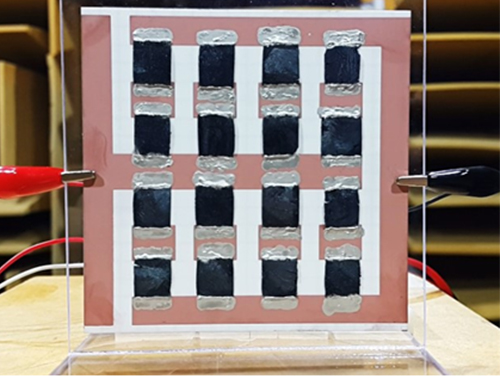 Extremely Thin and Highly Flexible Graphene-Based Thermoacoustic Speakers
A joint research team led by Professors Jung-Woo Choi and Byung Jin Cho of the School of Electrical Engineering and Professor Sang Ouk Kim of the Material Science and Engineering Department, all on the faculty of the Korea Advanced Institute of Science and Technology (KAIST), has developed a simpler way to mass-produce ultra-thin graphene thermosacoustic speakers.
Their research results were published online on August 17, 2016 in a journal called Applied Materials & Interfaces. The IEEE Spectrum, a monthly magazine published by the Institute of Electrical and Electronics Engineers, reported on the research on September 9, 2016, in an article titled, “Graphene Enables Flat Speakers for Mobile Audio Systems.” The American Chemical Society also drew attention to the team’s work in its article dated September 7, 2016, “Bringing Graphene Speakers to the Mobile Market.”
Thermoacoustic speakers generate sound waves from temperature fluctuations by rapidly heating and cooling conducting materials. Unlike conventional voice-coil speakers, thermoacoustic speakers do not rely on vibrations to produce sound, and thus do not need bulky acoustic boxes to keep complicated mechanical parts for sound production. They also generate good quality sound in all directions, enabling them to be placed on any surface including curved ones without canceling out sounds generated from opposite sides.
Based on a two-step, template-free fabrication method that involved freeze-drying a solution of graphene oxide flakes and the reduction/doping of oxidized graphene to improve electrical properties, the research team produced a N-doped, three-dimensional (3D), reduced graphene oxide aerogel (N-rGOA) with a porous macroscopic structure that permitted easy modulation for many potential applications.
Using 3D graphene aerogels, the team succeeded in fabricating an array of loudspeakers that were able to withstand over 40 W input power and that showed excellent sound pressure level (SPL), comparable to those of previously reported 2D and 3D graphene loudspeakers.
Choong Sun Kim, the lead author of the research paper and a doctoral student in the School of Electrical Engineering at KAIST, said:
“Thermoacoustic speakers have a higher efficiency when conducting materials have a smaller heat capacity. Nanomaterials such as graphene are an ideal candidate for conductors, but they require a substrate to support their extremely thinness. The substrate’s tendency to lose heat lowers the speakers’ efficiency. Here, we developed 3D graphene aerogels without a substrate by using a simple two-step process. With graphene aerogels, we have fabricated an array of loudspeakers that demonstrated stable performance. This is a practical technology that will enable mass-production of thermosacoustic speakers including on mobile platforms.”
The research paper is entitled “Application of N-Doped Three-Dimensional Reduced Graphene Oxide Aerogel to Thin Film Loudspeaker.” (DOI: 10.1021/acsami.6b03618)
Figure 1: A Thermoacoustic Loudspeaker Consisted of an Array of 16 3D Graphene Aerogels
Figure 2: Two-step Fabrication Process of 3D Reduced Graphene Oxide Aerogel Using Freeze-Drying and Reduction/Doping
Figure 3: X-ray Photoelectron Spectroscopy Graph of the 3D Reduced Graphene Oxide Aerogel and Its Scanning Electron Microscope Image
2016.10.05 View 15294
Extremely Thin and Highly Flexible Graphene-Based Thermoacoustic Speakers
A joint research team led by Professors Jung-Woo Choi and Byung Jin Cho of the School of Electrical Engineering and Professor Sang Ouk Kim of the Material Science and Engineering Department, all on the faculty of the Korea Advanced Institute of Science and Technology (KAIST), has developed a simpler way to mass-produce ultra-thin graphene thermosacoustic speakers.
Their research results were published online on August 17, 2016 in a journal called Applied Materials & Interfaces. The IEEE Spectrum, a monthly magazine published by the Institute of Electrical and Electronics Engineers, reported on the research on September 9, 2016, in an article titled, “Graphene Enables Flat Speakers for Mobile Audio Systems.” The American Chemical Society also drew attention to the team’s work in its article dated September 7, 2016, “Bringing Graphene Speakers to the Mobile Market.”
Thermoacoustic speakers generate sound waves from temperature fluctuations by rapidly heating and cooling conducting materials. Unlike conventional voice-coil speakers, thermoacoustic speakers do not rely on vibrations to produce sound, and thus do not need bulky acoustic boxes to keep complicated mechanical parts for sound production. They also generate good quality sound in all directions, enabling them to be placed on any surface including curved ones without canceling out sounds generated from opposite sides.
Based on a two-step, template-free fabrication method that involved freeze-drying a solution of graphene oxide flakes and the reduction/doping of oxidized graphene to improve electrical properties, the research team produced a N-doped, three-dimensional (3D), reduced graphene oxide aerogel (N-rGOA) with a porous macroscopic structure that permitted easy modulation for many potential applications.
Using 3D graphene aerogels, the team succeeded in fabricating an array of loudspeakers that were able to withstand over 40 W input power and that showed excellent sound pressure level (SPL), comparable to those of previously reported 2D and 3D graphene loudspeakers.
Choong Sun Kim, the lead author of the research paper and a doctoral student in the School of Electrical Engineering at KAIST, said:
“Thermoacoustic speakers have a higher efficiency when conducting materials have a smaller heat capacity. Nanomaterials such as graphene are an ideal candidate for conductors, but they require a substrate to support their extremely thinness. The substrate’s tendency to lose heat lowers the speakers’ efficiency. Here, we developed 3D graphene aerogels without a substrate by using a simple two-step process. With graphene aerogels, we have fabricated an array of loudspeakers that demonstrated stable performance. This is a practical technology that will enable mass-production of thermosacoustic speakers including on mobile platforms.”
The research paper is entitled “Application of N-Doped Three-Dimensional Reduced Graphene Oxide Aerogel to Thin Film Loudspeaker.” (DOI: 10.1021/acsami.6b03618)
Figure 1: A Thermoacoustic Loudspeaker Consisted of an Array of 16 3D Graphene Aerogels
Figure 2: Two-step Fabrication Process of 3D Reduced Graphene Oxide Aerogel Using Freeze-Drying and Reduction/Doping
Figure 3: X-ray Photoelectron Spectroscopy Graph of the 3D Reduced Graphene Oxide Aerogel and Its Scanning Electron Microscope Image
2016.10.05 View 15294 -
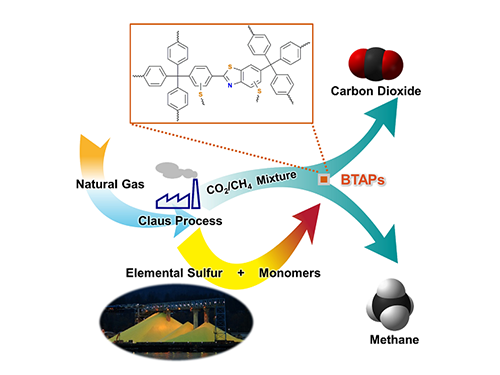 Direct Utilization of Elemental Sulfur for Microporous Polymer Synthesis
Using elemental sulfur as an alternative chemical feedstock, KAIST researchers have produced novel microporous polymers to sift CO2 from methane in natural-gas processing.
Methane, a primary component of natural gas, has emerged recently as an important energy source, largely owing to its abundance and relatively clean nature compared with other fossil fuels. In order to use natural gas as a fuel, however, it must undergo a procedure called “hydrodesulfurization” or “natural gas sweetening” to reduce sulfur-dioxide emissions from combustion of fossil fuels. This process leads to excessive and involuntary production of elemental sulfur. Although sulfur is one of the world’s most versatile and common elements, it has relatively few large-scale applications, mostly for gunpowder and sulfuric acid production.
Thus, the development of synthetic and processing methods to convert sulfur into useful chemicals remains a challenge. A research team led by Professor Ali Coskun from the Graduate School of EEWS (Energy, Environment, Water and Sustainability) at Korea Advanced Institute of Science and Technology (KAIST) has recently introduced a new approach to resolving this problem by employing elemental sulfur directly in the synthesis of microporous polymers for the process of natural-gas sweetening.
Natural gas, containing varying amounts of carbon dioxide (CO2) and hydrogen sulfide (H2S), is generally treated with amine solutions, followed by the regeneration of these solutions at increased temperatures to release captured CO2 and H2S. A two-step separation is involved in removing these gases. The amine solutions first remove H2S, and then CO2 is separated from methane (CH4) with either amine solutions or porous sorbents such as microporous polymers.
Using elemental sulfur and organic linkers, the research team developed a solvent and catalyst-free strategy for the synthesis of ultramicroporous benzothiazole polymers (BTAPs) in quantitative yields. BTAPs were found to be highly porous and showed exceptional physiochemical stability. In-situ chemical impregnation of sulfur within the micropores increased CO2 affinity of the sorbent, while limiting diffusion of CH4. BTAPs, as low-cost, scalable solid-sorbents, showed outstanding CO2 separation ability for flue gas, as well as for natural and landfill gas conditions.
The team noted that: “Each year, millions of tons of elemental sulfur are generated as a by-product of petroleum refining and natural-gas processing, but industries and businesses lacked good ideas for using it. Our research provides a solution: the direct utilization of elemental sulfur into the synthesis of ultramicroporous polymers that can be recycled back into an efficient and sustainable process for CO2 separation. Our novel polymeric materials offer new possibilities for the application of a little-used natural resource, sulfur, to provide a sustainable solution to challenging environmental issues.”
This work was published online in Chem on September 8, 2016 and also highlighted in C&EN (Chemical & Engineering News) by the American Chemical Society (ACS) on September 19, 2016. The research paper was entitled “Direct Utilization of Elemental Sulfur in the Synthesis of Microporous Polymers for Natural Gas Sweetening.” (DOI: 10.1016/j.chempr.2016.08.003)
Figure 1. A Schematic Image of Direct Utilization of Elemental Sulfur
This image shows direct utilization of elemental sulfur in the synthesis of microporous polymers and its gas separation performance.
Figure 2. BTAP’s Breakthrough Experiment under Pre-mixed Gas Conditions
This data presents the breakthrough measurements for CO2-containing binary gas-mixture streams with different feed-gas compositions to investigate the CO2 capture capacity of ultramicroporous benzothiazole polymers (BTAPs) for large-scale applications under simulated conditions of natural and landfill gases.
2016.10.05 View 9651
Direct Utilization of Elemental Sulfur for Microporous Polymer Synthesis
Using elemental sulfur as an alternative chemical feedstock, KAIST researchers have produced novel microporous polymers to sift CO2 from methane in natural-gas processing.
Methane, a primary component of natural gas, has emerged recently as an important energy source, largely owing to its abundance and relatively clean nature compared with other fossil fuels. In order to use natural gas as a fuel, however, it must undergo a procedure called “hydrodesulfurization” or “natural gas sweetening” to reduce sulfur-dioxide emissions from combustion of fossil fuels. This process leads to excessive and involuntary production of elemental sulfur. Although sulfur is one of the world’s most versatile and common elements, it has relatively few large-scale applications, mostly for gunpowder and sulfuric acid production.
Thus, the development of synthetic and processing methods to convert sulfur into useful chemicals remains a challenge. A research team led by Professor Ali Coskun from the Graduate School of EEWS (Energy, Environment, Water and Sustainability) at Korea Advanced Institute of Science and Technology (KAIST) has recently introduced a new approach to resolving this problem by employing elemental sulfur directly in the synthesis of microporous polymers for the process of natural-gas sweetening.
Natural gas, containing varying amounts of carbon dioxide (CO2) and hydrogen sulfide (H2S), is generally treated with amine solutions, followed by the regeneration of these solutions at increased temperatures to release captured CO2 and H2S. A two-step separation is involved in removing these gases. The amine solutions first remove H2S, and then CO2 is separated from methane (CH4) with either amine solutions or porous sorbents such as microporous polymers.
Using elemental sulfur and organic linkers, the research team developed a solvent and catalyst-free strategy for the synthesis of ultramicroporous benzothiazole polymers (BTAPs) in quantitative yields. BTAPs were found to be highly porous and showed exceptional physiochemical stability. In-situ chemical impregnation of sulfur within the micropores increased CO2 affinity of the sorbent, while limiting diffusion of CH4. BTAPs, as low-cost, scalable solid-sorbents, showed outstanding CO2 separation ability for flue gas, as well as for natural and landfill gas conditions.
The team noted that: “Each year, millions of tons of elemental sulfur are generated as a by-product of petroleum refining and natural-gas processing, but industries and businesses lacked good ideas for using it. Our research provides a solution: the direct utilization of elemental sulfur into the synthesis of ultramicroporous polymers that can be recycled back into an efficient and sustainable process for CO2 separation. Our novel polymeric materials offer new possibilities for the application of a little-used natural resource, sulfur, to provide a sustainable solution to challenging environmental issues.”
This work was published online in Chem on September 8, 2016 and also highlighted in C&EN (Chemical & Engineering News) by the American Chemical Society (ACS) on September 19, 2016. The research paper was entitled “Direct Utilization of Elemental Sulfur in the Synthesis of Microporous Polymers for Natural Gas Sweetening.” (DOI: 10.1016/j.chempr.2016.08.003)
Figure 1. A Schematic Image of Direct Utilization of Elemental Sulfur
This image shows direct utilization of elemental sulfur in the synthesis of microporous polymers and its gas separation performance.
Figure 2. BTAP’s Breakthrough Experiment under Pre-mixed Gas Conditions
This data presents the breakthrough measurements for CO2-containing binary gas-mixture streams with different feed-gas compositions to investigate the CO2 capture capacity of ultramicroporous benzothiazole polymers (BTAPs) for large-scale applications under simulated conditions of natural and landfill gases.
2016.10.05 View 9651 -
 KAIST Ranked the World's Sixth Most Innovative University
KAIST took sixth place in the list of “The World’s Top 100 Most Innovative Universities.” Thomson Reuters released the list on September 28, 2016, which was based on the data compiled by its division of Intellectual Property & Science such as patent filings, number of research papers and their citations, and industry collaboration. American universities took ranks from first to fifth; KAIST was the only non-American university that ranked highest in the list. Stressing the importance of linking basic research with commercializing efforts, Thomson Reuters said, the listed universities were “doing the most to advance science, invent new technologies and help drive the global economy.”
For details, go to the link below:
Reuters Top 100: The World’s Most Innovative Universities-2016
September 28, 2016
http://www.reuters.com/article/amers-reuters-ranking-innovative-univers-idUSL2N1C406D
2016.09.29 View 6341
KAIST Ranked the World's Sixth Most Innovative University
KAIST took sixth place in the list of “The World’s Top 100 Most Innovative Universities.” Thomson Reuters released the list on September 28, 2016, which was based on the data compiled by its division of Intellectual Property & Science such as patent filings, number of research papers and their citations, and industry collaboration. American universities took ranks from first to fifth; KAIST was the only non-American university that ranked highest in the list. Stressing the importance of linking basic research with commercializing efforts, Thomson Reuters said, the listed universities were “doing the most to advance science, invent new technologies and help drive the global economy.”
For details, go to the link below:
Reuters Top 100: The World’s Most Innovative Universities-2016
September 28, 2016
http://www.reuters.com/article/amers-reuters-ranking-innovative-univers-idUSL2N1C406D
2016.09.29 View 6341 -
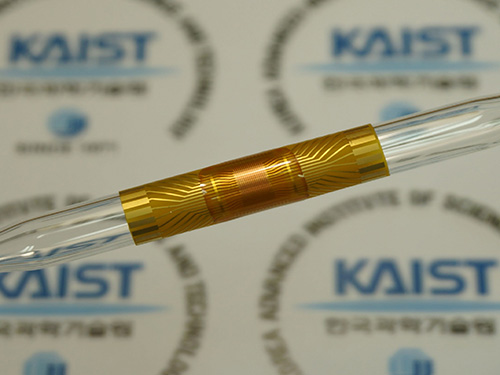 Continuous Roll-Process Technology for Transferring and Packaging Flexible Large-Scale Integrated Circuits
A research team led by Professor Keon Jae Lee from KAIST and by Dr. Jae-Hyun Kim from the Korea Institute of Machinery and Materials (KIMM) has jointly developed a continuous roll-processing technology that transfers and packages flexible large-scale integrated circuits (LSI), the key element in constructing the computer’s brain such as CPU, on plastics to realize flexible electronics.
Professor Lee previously demonstrated the silicon-based flexible LSIs using 0.18 CMOS (complementary metal-oxide semiconductor) process in 2013 (ACS Nano, “In Vivo Silicon-based Flexible Radio Frequency Integrated Circuits Monolithically Encapsulated with Biocompatible Liquid Crystal Polymers”) and presented the work in an invited talk of 2015 International Electron Device Meeting (IEDM), the world’s premier semiconductor forum.
Highly productive roll-processing is considered a core technology for accelerating the commercialization of wearable computers using flexible LSI. However, realizing it has been a difficult challenge not only from the roll-based manufacturing perspective but also for creating roll-based packaging for the interconnection of flexible LSI with flexible displays, batteries, and other peripheral devices.
To overcome these challenges, the research team started fabricating NAND flash memories on a silicon wafer using conventional semiconductor processes, and then removed a sacrificial wafer leaving a top hundreds-nanometer-thick circuit layer. Next, they simultaneously transferred and interconnected the ultrathin device on a flexible substrate through the continuous roll-packaging technology using anisotropic conductive film (ACF). The final silicon-based flexible NAND memory successfully demonstrated stable memory operations and interconnections even under severe bending conditions. This roll-based flexible LSI technology can be potentially utilized to produce flexible application processors (AP), high-density memories, and high-speed communication devices for mass manufacture.
Professor Lee said, “Highly productive roll-process was successfully applied to flexible LSIs to continuously transfer and interconnect them onto plastics. For example, we have confirmed the reliable operation of our flexible NAND memory at the circuit level by programming and reading letters in ASCII codes. Out results may open up new opportunities to integrate silicon-based flexible LSIs on plastics with the ACF packing for roll-based manufacturing.”
Dr. Kim added, “We employed the roll-to-plate ACF packaging, which showed outstanding bonding capability for continuous roll-based transfer and excellent flexibility of interconnecting core and peripheral devices. This can be a key process to the new era of flexible computers combining the already developed flexible displays and batteries.”
The team’s results will be published on the front cover of Advanced Materials (August 31, 2016) in an article entitled “Simultaneous Roll Transfer and Interconnection of Silicon NAND Flash Memory.” (DOI: 10.1002/adma.201602339)
YouTube Link: https://www.youtube.com/watch?v=8OJjAEm27sw
Picture 1: This schematic image shows the flexible silicon NAND flash memory produced by the simultaneous roll-transfer and interconnection process.
Picture 2: The flexible silicon NAND flash memory is attached to a 7 mm diameter glass rod.
2016.09.01 View 12680
Continuous Roll-Process Technology for Transferring and Packaging Flexible Large-Scale Integrated Circuits
A research team led by Professor Keon Jae Lee from KAIST and by Dr. Jae-Hyun Kim from the Korea Institute of Machinery and Materials (KIMM) has jointly developed a continuous roll-processing technology that transfers and packages flexible large-scale integrated circuits (LSI), the key element in constructing the computer’s brain such as CPU, on plastics to realize flexible electronics.
Professor Lee previously demonstrated the silicon-based flexible LSIs using 0.18 CMOS (complementary metal-oxide semiconductor) process in 2013 (ACS Nano, “In Vivo Silicon-based Flexible Radio Frequency Integrated Circuits Monolithically Encapsulated with Biocompatible Liquid Crystal Polymers”) and presented the work in an invited talk of 2015 International Electron Device Meeting (IEDM), the world’s premier semiconductor forum.
Highly productive roll-processing is considered a core technology for accelerating the commercialization of wearable computers using flexible LSI. However, realizing it has been a difficult challenge not only from the roll-based manufacturing perspective but also for creating roll-based packaging for the interconnection of flexible LSI with flexible displays, batteries, and other peripheral devices.
To overcome these challenges, the research team started fabricating NAND flash memories on a silicon wafer using conventional semiconductor processes, and then removed a sacrificial wafer leaving a top hundreds-nanometer-thick circuit layer. Next, they simultaneously transferred and interconnected the ultrathin device on a flexible substrate through the continuous roll-packaging technology using anisotropic conductive film (ACF). The final silicon-based flexible NAND memory successfully demonstrated stable memory operations and interconnections even under severe bending conditions. This roll-based flexible LSI technology can be potentially utilized to produce flexible application processors (AP), high-density memories, and high-speed communication devices for mass manufacture.
Professor Lee said, “Highly productive roll-process was successfully applied to flexible LSIs to continuously transfer and interconnect them onto plastics. For example, we have confirmed the reliable operation of our flexible NAND memory at the circuit level by programming and reading letters in ASCII codes. Out results may open up new opportunities to integrate silicon-based flexible LSIs on plastics with the ACF packing for roll-based manufacturing.”
Dr. Kim added, “We employed the roll-to-plate ACF packaging, which showed outstanding bonding capability for continuous roll-based transfer and excellent flexibility of interconnecting core and peripheral devices. This can be a key process to the new era of flexible computers combining the already developed flexible displays and batteries.”
The team’s results will be published on the front cover of Advanced Materials (August 31, 2016) in an article entitled “Simultaneous Roll Transfer and Interconnection of Silicon NAND Flash Memory.” (DOI: 10.1002/adma.201602339)
YouTube Link: https://www.youtube.com/watch?v=8OJjAEm27sw
Picture 1: This schematic image shows the flexible silicon NAND flash memory produced by the simultaneous roll-transfer and interconnection process.
Picture 2: The flexible silicon NAND flash memory is attached to a 7 mm diameter glass rod.
2016.09.01 View 12680 -
 KAIST Named Asia's Most Innovative University by Thomson Reuters
Thomson Reuters ranked KAIST first among Asia’s top most innovative universities in a list that it released on August 30, 2016. Seventy-five Asian universities received this distinction.
Thomson Reuters created the list to identify those educational institutions that are “doing the most to advance science, invent new technologies, and help drive the global economy.”
The rankings were based on data drawn from each academic institution's research papers and patent filing information as evaluated by the Intellectual Property & Science division of Thomson Reuters.
Thomson Reuters described KAIST as producing "original and influential research" and noted that other organizations cited its patent portfolios as "significant prior art in their own patent applications, a strong indicator that the university has an outsized impact on global research and development."
For details, please go to the link below:
Asia’s Most Innovative Universities
Reuters
August 30, 2016
http://www.reuters.com/article/us-asiapac-reuters-ranking-innovative-un-idUSKCN1152B7#listing
2016.08.31 View 5950
KAIST Named Asia's Most Innovative University by Thomson Reuters
Thomson Reuters ranked KAIST first among Asia’s top most innovative universities in a list that it released on August 30, 2016. Seventy-five Asian universities received this distinction.
Thomson Reuters created the list to identify those educational institutions that are “doing the most to advance science, invent new technologies, and help drive the global economy.”
The rankings were based on data drawn from each academic institution's research papers and patent filing information as evaluated by the Intellectual Property & Science division of Thomson Reuters.
Thomson Reuters described KAIST as producing "original and influential research" and noted that other organizations cited its patent portfolios as "significant prior art in their own patent applications, a strong indicator that the university has an outsized impact on global research and development."
For details, please go to the link below:
Asia’s Most Innovative Universities
Reuters
August 30, 2016
http://www.reuters.com/article/us-asiapac-reuters-ranking-innovative-un-idUSKCN1152B7#listing
2016.08.31 View 5950 -
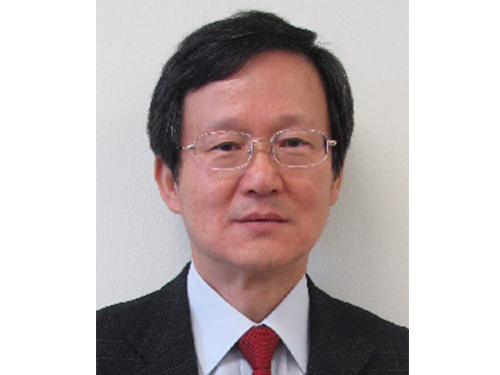 Professor Lee to Head the Addis Ababa Institute of Technology
Emeritus Professor In Lee of the Department of Aerospace Engineering at KAIST was appointed to the post of President of the Addis Ababa Institute of Technology (AAiT) in Ethiopia. His term will begin on August 1, 2016 and end on July 31, 2018, which can be extended up to five years.
AAiT is an affiliated institute of Addis Ababa University, a distinguished national university in Ethiopia, and specializes in education and research in engineering and technology. There are currently 5,500 undergraduate and 4,500 graduate students enrolled at the institute.
The Ethiopian government has recognized the importance of science and technology for the future of the country. The government intends to develop AAiT into a distinguished research university similar to KAIST, and thus sought advice from KAIST to recommend an administrator who will head AAiT. Upon recommendation by KAIST President Steve Kang, Professor Lee was appointed.
Professor Lee graduated from Seoul National University with bachelor's and master’s degrees in aeronautical engineering and earned his Ph.D. in aeronautics from Stanford University.
He has served as the President of The Korean Society for Aeronautics and Space Sciences, the Director of the KAIST Satellite Technology Research Center, and a Research Associate at NASA Ames Research Center.
2016.08.03 View 9677
Professor Lee to Head the Addis Ababa Institute of Technology
Emeritus Professor In Lee of the Department of Aerospace Engineering at KAIST was appointed to the post of President of the Addis Ababa Institute of Technology (AAiT) in Ethiopia. His term will begin on August 1, 2016 and end on July 31, 2018, which can be extended up to five years.
AAiT is an affiliated institute of Addis Ababa University, a distinguished national university in Ethiopia, and specializes in education and research in engineering and technology. There are currently 5,500 undergraduate and 4,500 graduate students enrolled at the institute.
The Ethiopian government has recognized the importance of science and technology for the future of the country. The government intends to develop AAiT into a distinguished research university similar to KAIST, and thus sought advice from KAIST to recommend an administrator who will head AAiT. Upon recommendation by KAIST President Steve Kang, Professor Lee was appointed.
Professor Lee graduated from Seoul National University with bachelor's and master’s degrees in aeronautical engineering and earned his Ph.D. in aeronautics from Stanford University.
He has served as the President of The Korean Society for Aeronautics and Space Sciences, the Director of the KAIST Satellite Technology Research Center, and a Research Associate at NASA Ames Research Center.
2016.08.03 View 9677